Play Research Demonstrates Chicago Should Provide Recess in Every School
March 25, 2009
I was asked to do a presentation about recess at a conference for the Association for Childhood Education International, and came up with a bunch of new research on the importance of play... just wanted to share, this is an excerpt:
Presentation to the Association for Childhood Education International (ACEI), March 2009.
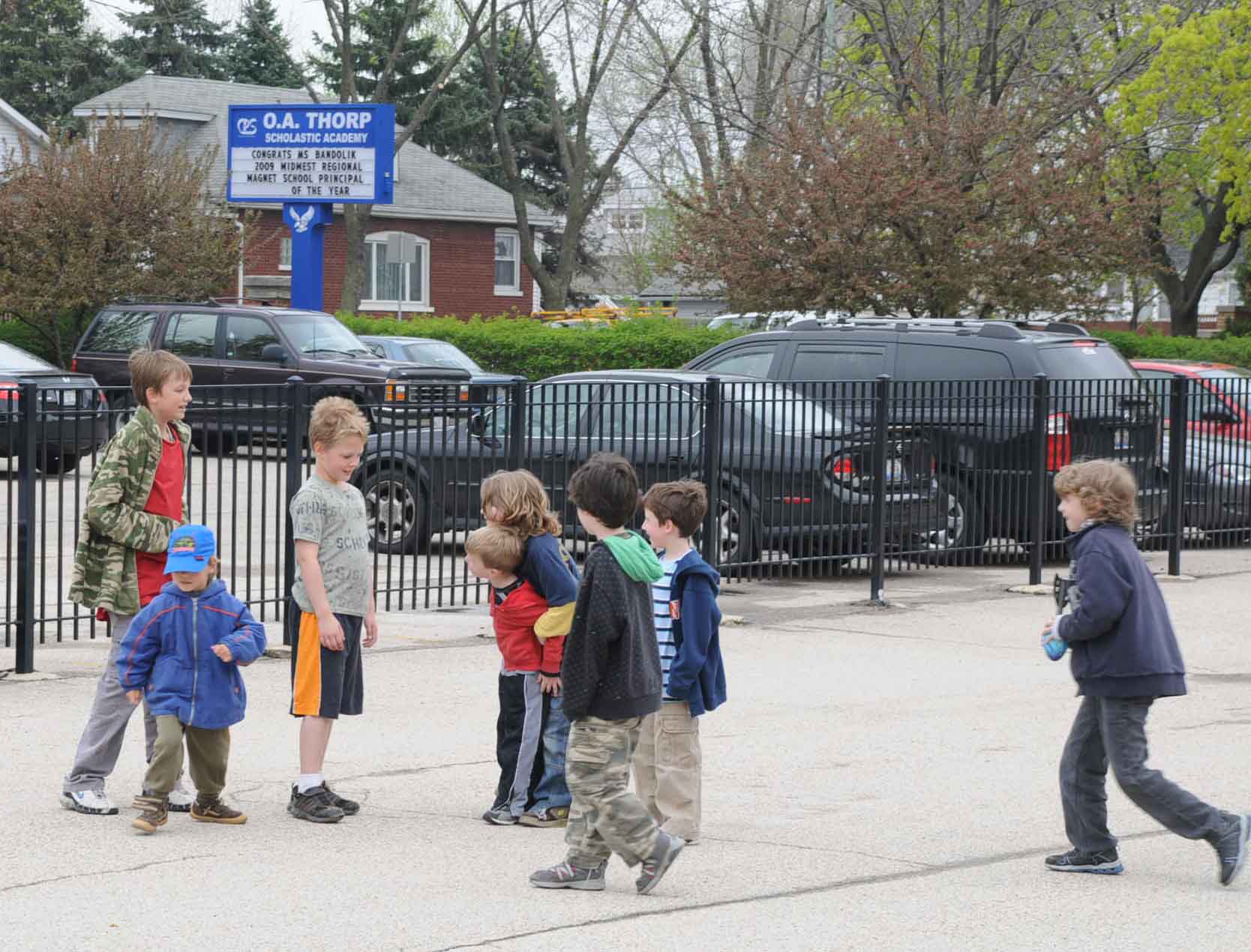 Boys from O.A. Thorp playing after school in April 2009. Substance photo by George N. Schmidt.In animal life, the smarter the organism, the more it plays. We have dozens of great professors who have spent years researching children’s needs. Psychiatrists, pediatricians, all have researched and written about the importance of play for childhood development. Unfortunately most of their findings never make it to the general public.
Boys from O.A. Thorp playing after school in April 2009. Substance photo by George N. Schmidt.In animal life, the smarter the organism, the more it plays. We have dozens of great professors who have spent years researching children’s needs. Psychiatrists, pediatricians, all have researched and written about the importance of play for childhood development. Unfortunately most of their findings never make it to the general public.
Chicago appears committed to play. We have installed state of the art playgrounds in hundreds of schools. But the actual state of play for Chicago’s children is not so great. Only a third of our schools say they provide recess, and most that do only provide it a few times per month. Our schools only provide phys ed class once per week.
Cities provide a tough landscape for many children when it comes to play opportunities. Many children live on busy streets, have stressed parents and broken homes, too much video entertainment, and violent neighborhoods. These are the types of children who need recess the most. Right now the majority of children in our city have never had a school recess.
I heard President Obama make a statement in regard to the economic stimulus funds sent to states for public education: “We are going to help state and local educators focus on achieving real improvement in our classrooms and help children to perform and prepare them for the 21st century economy”.
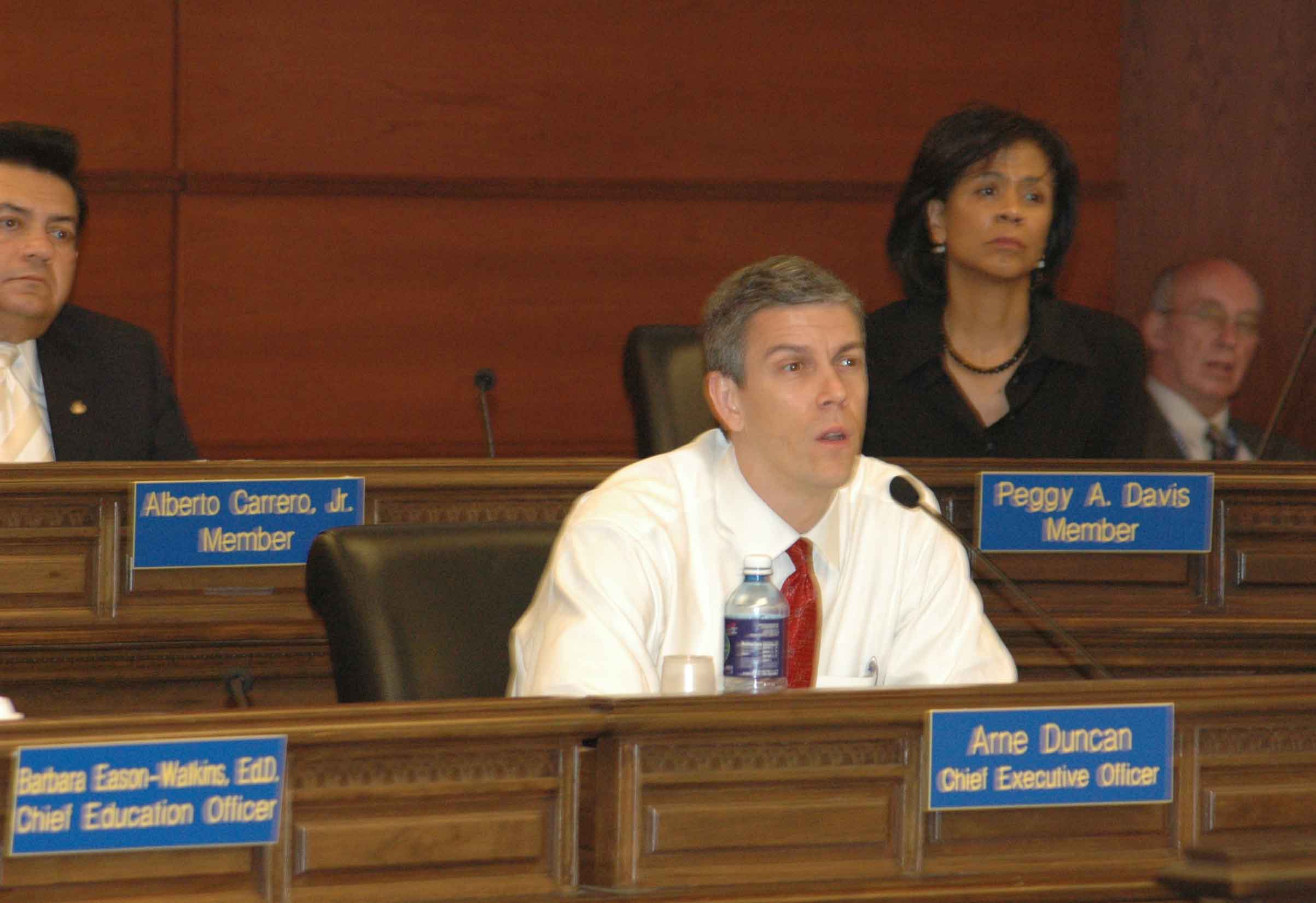 Then Chicago CEO Arne Duncan responding to criticisms from Amy Lux regarding the implementation of Chicago's recess policy. Substance photo by George N. Schmidt.His new secretary of education, Arne Duncan, who served as our Chicago Public Schools Chief Executive Officer during the last 8 years, reiterated the cause.
Then Chicago CEO Arne Duncan responding to criticisms from Amy Lux regarding the implementation of Chicago's recess policy. Substance photo by George N. Schmidt.His new secretary of education, Arne Duncan, who served as our Chicago Public Schools Chief Executive Officer during the last 8 years, reiterated the cause.
We really need to ask ourselves, what is the most important thing educational systems can instill in its future generations? Is it the ability for rote memorization of facts? Or is it going to be an ability for creative thought, development of new products, and flexible problem solving skills.
Imaginative play grows artistic, creative capacities, flexible, creative thinking, and intuitive social awareness. Our educational systems seem to have forgotten that we are supposed to be teaching children how to think rather than what to think. As academics get pushed on younger and younger children, they lose the ability to think outside of the box. Many think that play is a waste of time, something we do when the important things in life are taken care of.
It turns out to be just the opposite. Play is a unique state that unlocks all of our intuitive intelligence and hidden capacities. When adult cultures refuse to honor the need for spontaneous play, they lose their creative essence. The children that are going to make it in the next generation are the kids that are curious, who can develop new ideas, who can invent something that will be useful.
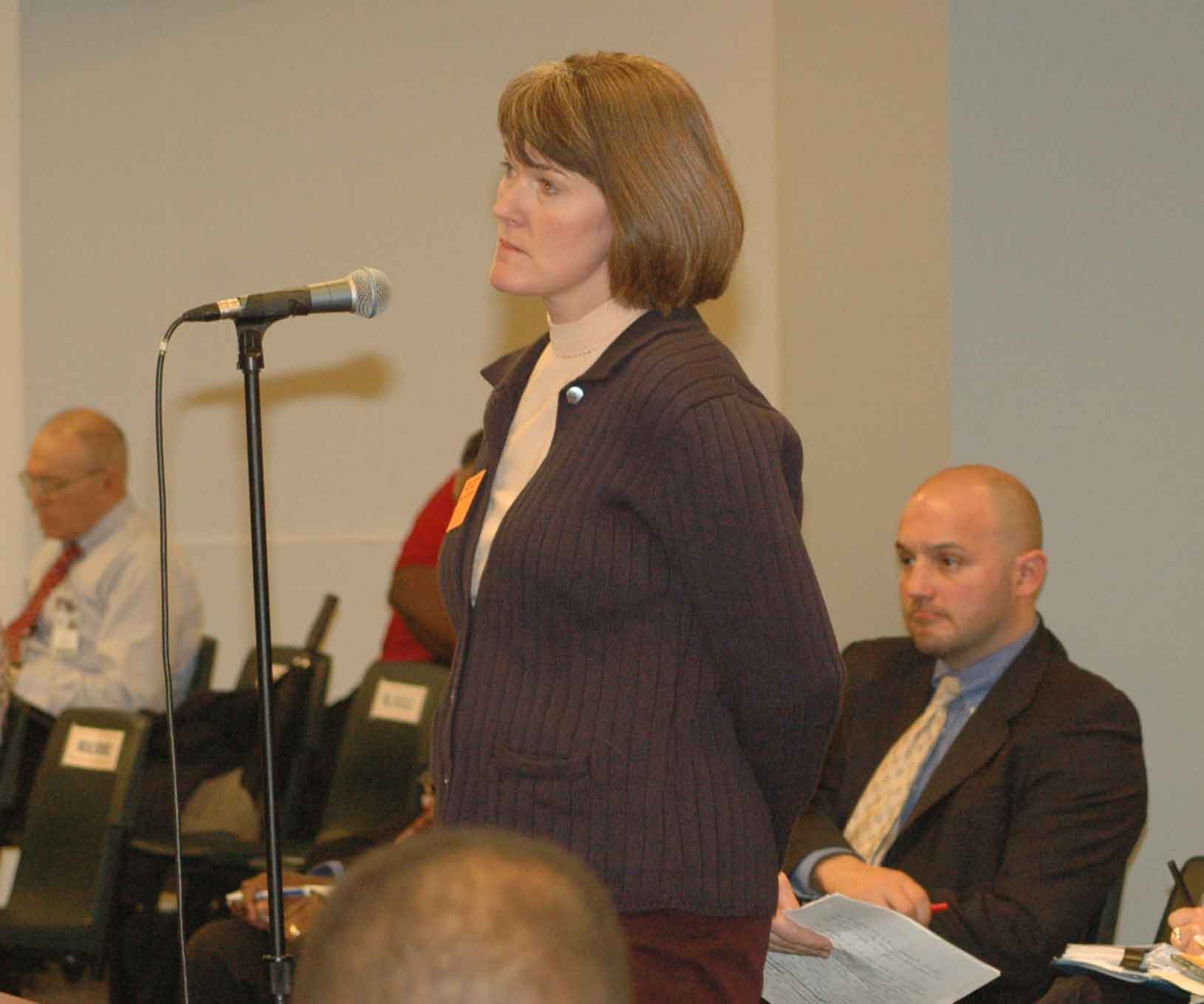 Amy Lux speaking to the Board. Substance photo by George N. Schmidt.Our education system rewards compulsivity and rote memorization. This is important, but one also needs to be able to play with their context for factual basics. If you look at Einstein or Mozart, or other creative geniuses, their life was made up of imaginative manipulation of narratives, mathematical symbols, sounds and notes, colors or forms. They found true joy in their being using imaginative capacities by playing with the objects they loved. Einstein said that "imagination is more important than knowledge.” If we start valuing play more, we’d be paying attention in new ways, with beginners mind, with the eyes of a child. We’d see options and possibilities to solve some of the enormous problems we have. Playfulness is woven into our biology. We were never intended to grow into dull, conditioned, petty, prejudiced, miserable adults.
Amy Lux speaking to the Board. Substance photo by George N. Schmidt.Our education system rewards compulsivity and rote memorization. This is important, but one also needs to be able to play with their context for factual basics. If you look at Einstein or Mozart, or other creative geniuses, their life was made up of imaginative manipulation of narratives, mathematical symbols, sounds and notes, colors or forms. They found true joy in their being using imaginative capacities by playing with the objects they loved. Einstein said that "imagination is more important than knowledge.” If we start valuing play more, we’d be paying attention in new ways, with beginners mind, with the eyes of a child. We’d see options and possibilities to solve some of the enormous problems we have. Playfulness is woven into our biology. We were never intended to grow into dull, conditioned, petty, prejudiced, miserable adults.
We are designed by nature to retain our playful, childlike countenance throughout life. We are a playful species, whether we are six months or 60 years. If we don’t live by our design, we aren’t going to make it.
The trend in education today is to focus on developing the right side of the brain. A clown puts on a big red nose to indicate that she is free to be creative and think outside "the box." 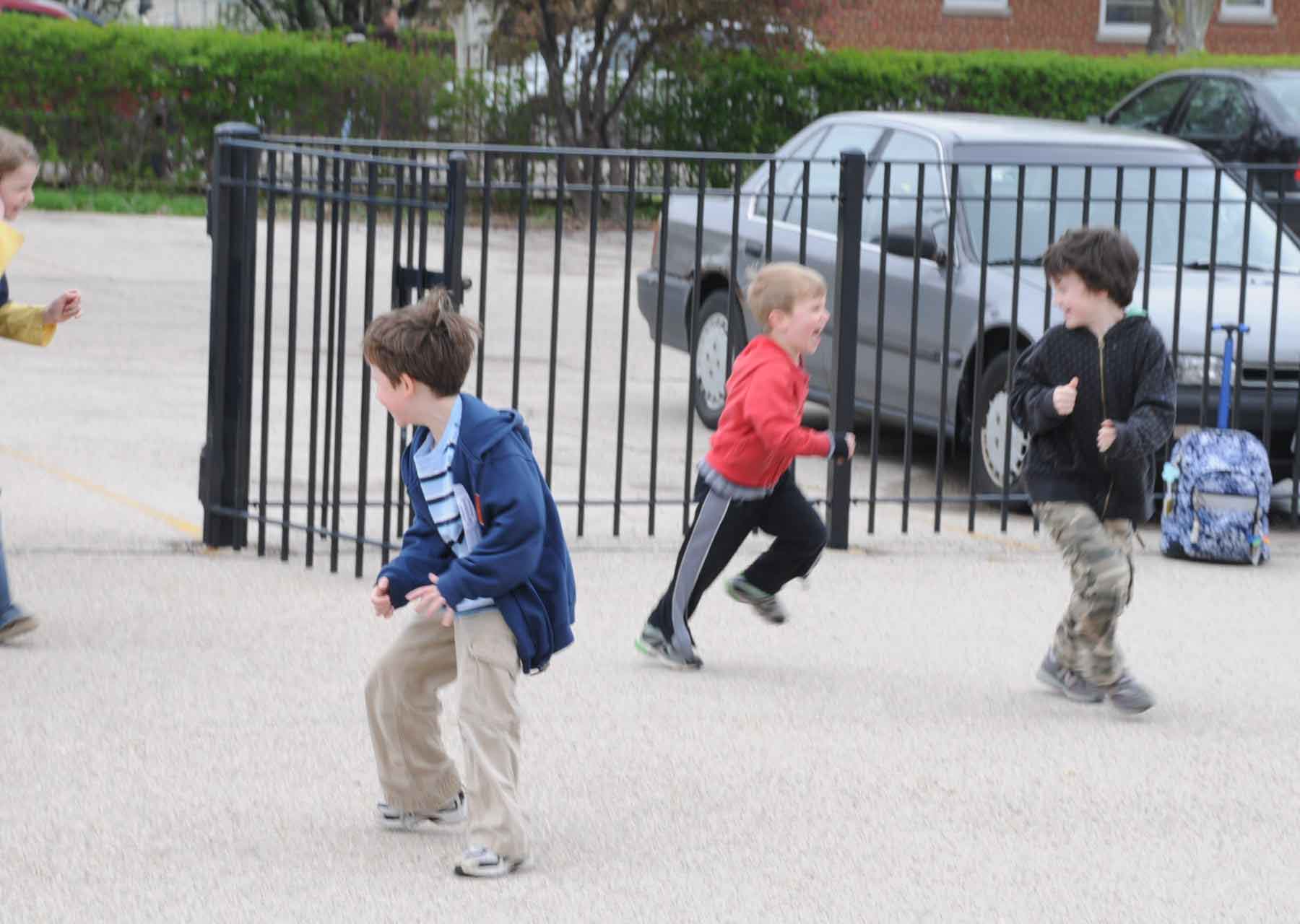 Substance Early Childhood Editor Joshua Schmidt (center), four years old, joins O.A. Thorp students in after school play. Substance photo by George N. Schmidt.Most play enriched people do not need make-up and baggy pants to be freethinking and fun loving. The current educational system encourages our thinking patterns to engage in predictable, repetitive patterns. Throughout history, famous philosophers have told us to “look to the children”, for answers to life’s more intricate puzzles. We need to turn to the children and appreciate their playful nature, watch with wonder how their innate curiosity, their flexibility and humor keeps them free, listen to their intuitively intelligent summaries that never cease to amaze, and think twice before we try to stuff them back into a box.
Substance Early Childhood Editor Joshua Schmidt (center), four years old, joins O.A. Thorp students in after school play. Substance photo by George N. Schmidt.Most play enriched people do not need make-up and baggy pants to be freethinking and fun loving. The current educational system encourages our thinking patterns to engage in predictable, repetitive patterns. Throughout history, famous philosophers have told us to “look to the children”, for answers to life’s more intricate puzzles. We need to turn to the children and appreciate their playful nature, watch with wonder how their innate curiosity, their flexibility and humor keeps them free, listen to their intuitively intelligent summaries that never cease to amaze, and think twice before we try to stuff them back into a box.
All children are born artists. The problem is to remain an artist as we grow up. We don’t grow into creativity, we grow out of it. Every education system has a hierarchy of subjects. Art and music are always at the bottom. Play is not even on the list. States have to go to great lengths to create laws to protect physical education, but no one is around to effectively enforce these laws. In music class we have singing, but why not dance?
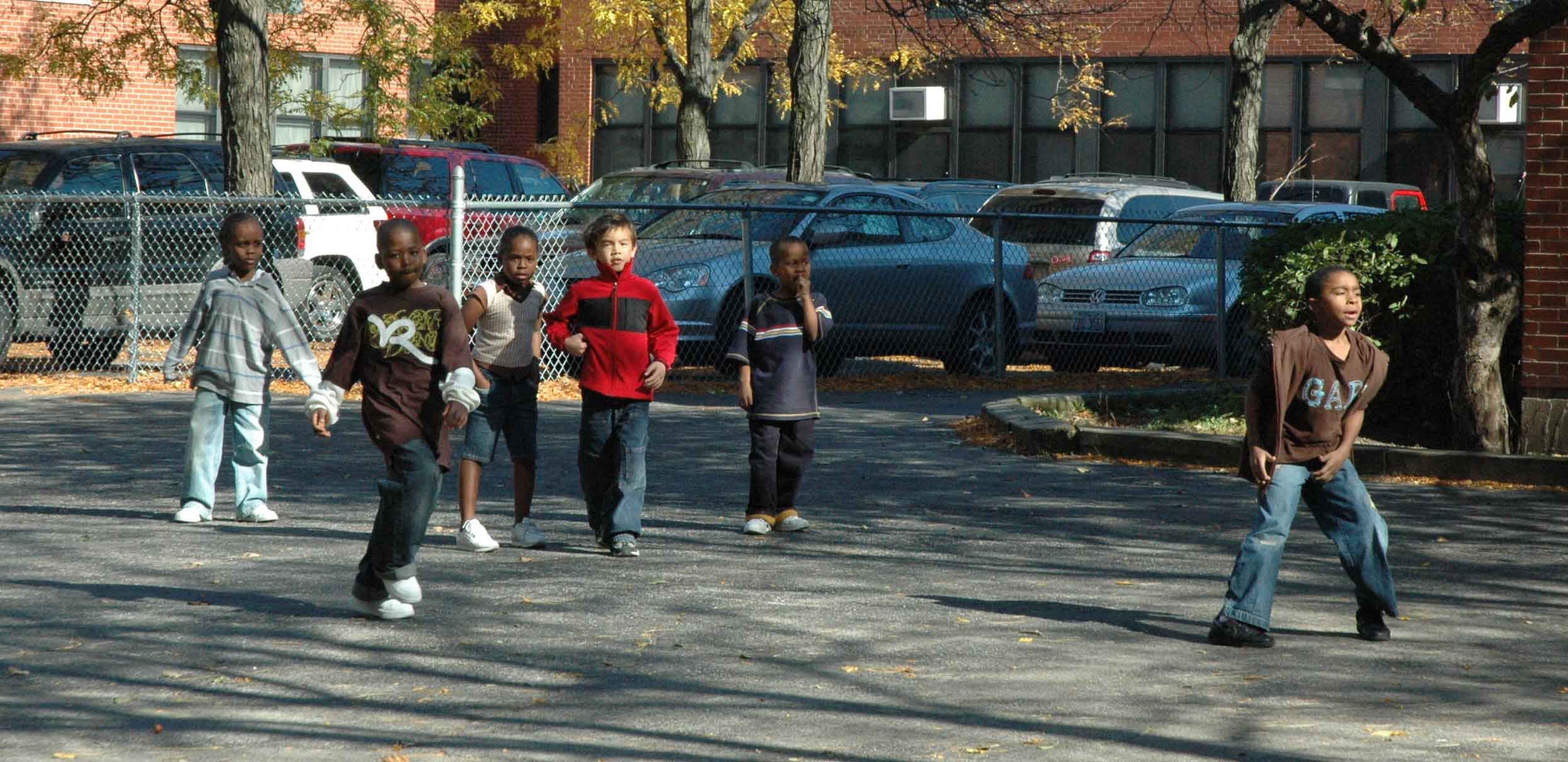 Students at Chicago's Oscar Mayer school enjoy recess on October 30, 2007. Substance photo by George N. Schmidt.We educate from the waste up. You would think that the sole purpose of education across the world is to produce university professors. They are what is rewarded, who come out at the top, these people who live in their heads. Most are disembodied. They look at their bodies as a form of transport for their heads. If you want proof of this, go to a senior academic conference and pop into their dance floor on a Friday night. Grown men and women moving horribly off beat, waiting for it to end so they can run home and write a paper about it. Every competitive educational system across the planet appears to be in the business of getting students ready for university careers. Yet many of the most highly creative, intelligent people never make it to university because they can not navigate the right brain system of education.
Students at Chicago's Oscar Mayer school enjoy recess on October 30, 2007. Substance photo by George N. Schmidt.We educate from the waste up. You would think that the sole purpose of education across the world is to produce university professors. They are what is rewarded, who come out at the top, these people who live in their heads. Most are disembodied. They look at their bodies as a form of transport for their heads. If you want proof of this, go to a senior academic conference and pop into their dance floor on a Friday night. Grown men and women moving horribly off beat, waiting for it to end so they can run home and write a paper about it. Every competitive educational system across the planet appears to be in the business of getting students ready for university careers. Yet many of the most highly creative, intelligent people never make it to university because they can not navigate the right brain system of education.
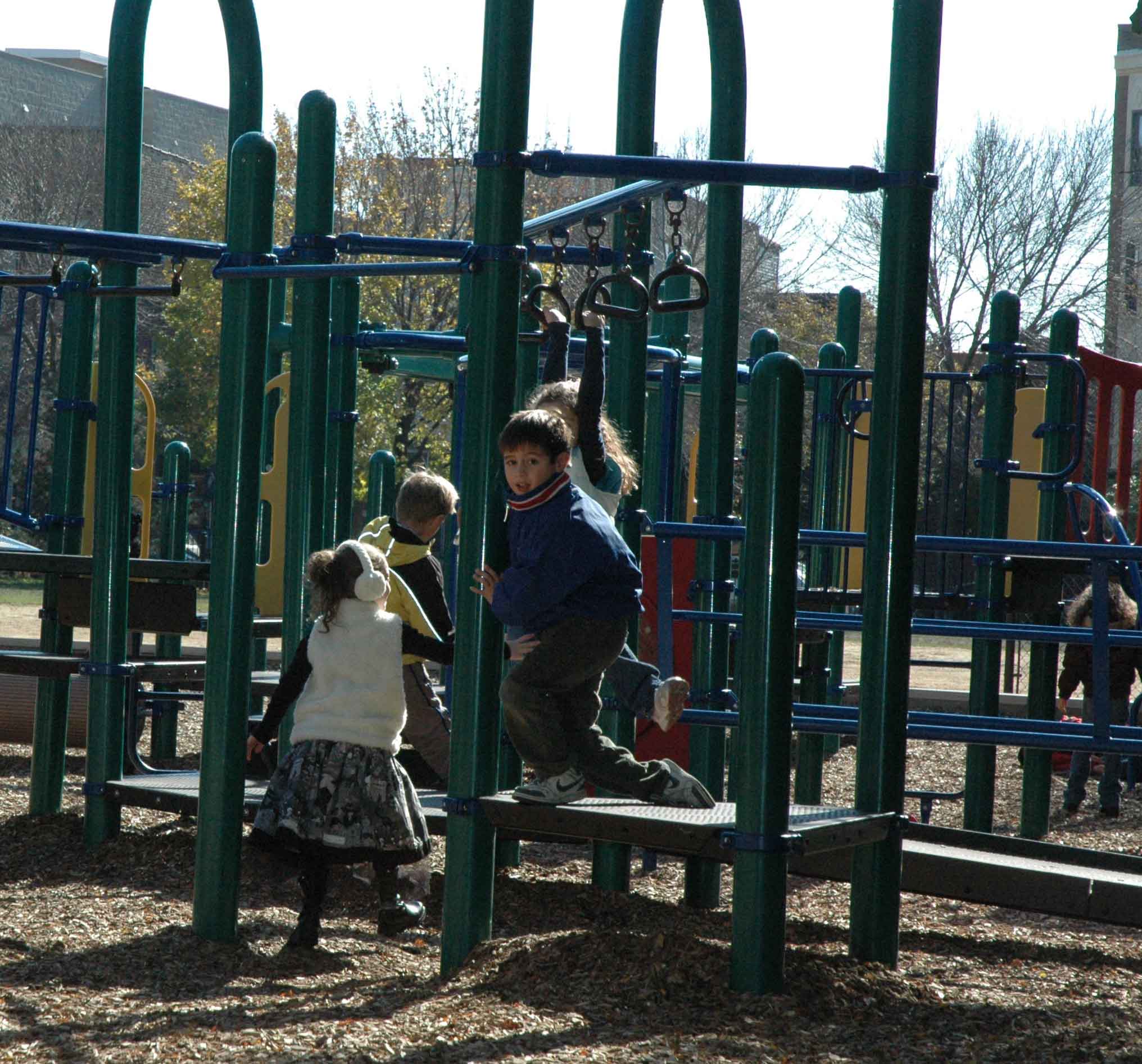 Oscar Mayer students at recess also enjoyed playing on the school's apparatus. Substance photo by George N. Schmidt.The prevalence of depression, stress-related diseases, interpersonal violence, and addiction, can be linked, like a deficiency disease, to the prolonged deprivation of play. Most children from the poorest, most violent parts of the world grow up with little or no play opportunities. The physical and emotional costs of poverty rob people of joy. These children deal with parents who often have their heads down, worried about survival, they have little energy to play.
Oscar Mayer students at recess also enjoyed playing on the school's apparatus. Substance photo by George N. Schmidt.The prevalence of depression, stress-related diseases, interpersonal violence, and addiction, can be linked, like a deficiency disease, to the prolonged deprivation of play. Most children from the poorest, most violent parts of the world grow up with little or no play opportunities. The physical and emotional costs of poverty rob people of joy. These children deal with parents who often have their heads down, worried about survival, they have little energy to play.
Play is used by children to heal from trauma. You see children playing on the shore after the tsunami, in the rubble of hurricane Katrina, in war-torn countries. Therapists use art and play with these children as a way to cope with post traumatic stress. But for many children there is no safe space to be carefree and playful. For these children school recess may be the only possibility for a safe play space.
Last year, a Chicago newspaper interviewed 500 students at three elementary schools in tough areas. Half of them knew of someone who had been shot at and a one-third knew someone who was killed. These students felt trapped inside their own homes. None of the three schools provided recess. One boy, aged 13, knew nine people who had been shot, three fatally. He listed off the places he couldn’t go for fear of violence — the park, the neighborhood pool, the basketball court. Many children said they did not feel safe playing in their front yards.
Any traumatic event causes one to turn off the receptive centers of the brain. Children have many real and perceived traumas. For children in violent neighborhoods, the trauma is severe. They look at the world as an enemy and build emotional defensive structures to protect themselves from it. Anxiety ridden children have a 30% reduction in sensory intake. This is basically like turning off the brain instead of turning it on. Instead of being fresh, alert and ready to learn, they come into class with a good portion of their brain dormant.
If you look at children from play deprived communities, who live under tremendous stress, inner city youth from violent communities, look at their drawings and get them to write stories, you will see that they have very little ability to cope, or deal with their own dis-empowerment.
Rough and tumble play, generally unappreciated by teachers, who see hitting, diving, wrestling, not as play, but as anarchy that must be controlled, is actually a necessary competitive early childhood ritual which diminishes with age. It teaches children to tolerate and enjoy creative tension. Lack of experience with this type of play hampers mastery of the necessary give and take in social situations later in life. It has been linked to poor control of violent impulses in adolescence.
Studies of criminal activity including drug users and repeat drunk driving offenders show that these individuals have play deprived childhoods. They absorb stress because they have never learned other options to relieve it. The drugs produce responses in the brain that are very much like that received from the relaxation response that comes with getting into a zone of play. This zone of play is almost hypnotic, a true brilliance appears in a decent athlete, an intuition of the body to know how much force and effort to put into each and every move in order to gain maximum effect. The goal of many spiritual practices is to empty or free the mind in order to access intuitive intelligence. A child needs to be totally free of adult instruction while developing this state of mind. Many children today never experience this state of play. They are going to be severely handicapped when it comes to dealing with the stresses of everyday life.
In both animals and children, play has an almost spiritual quality about it. As we get older, all of us need moments of spontaneity and joyfulness or we get depressed and feel powerless. We become angry human beings that might be capable economically, but not very effective intra-psychically or spiritually.
Adults who have embraced playfulness, who can embrace adversity in relationships with humor and flexibility have a repertoire of responses to the world. If you get poor, you can respond to it, if there is sadness, you have some sense of imaginative capacity to deal with it. But if you have a fixed, rigid view of yourself and the world, which is an inevitable outcome of a playless life, you go out the window when the depression hits. For the creatively inclined, you think hey, this is kind of an opportunity, I haven’t dealt with this situation before.
Each person has a unique play personality ... when one remains in touch with it. ... and keeps it actualized, it empowers and brings pleasure to life. Plato said, “You can discover more about a person in an hour of play than in a year of conversation."
Play is intrinsically rewarding. It makes perseverance fun. Part of play and art is that there is no wrong. This is fundamental in early development. National education systems tell us that a mistake is the worse thing. The result is that we educate people out of their creative capacities. A child was drawing a picture, and someone asked, “what is that?”. The child responded “Its God”. “But no one knows what god looks like”, and she said “They will in a minute”. In play, kids can take chances, explore movements that are not open to censure. They are not being given directions as they are in other classes, early athletic programs or formal physical education. Its this safe zone to explore and make mistakes that allows them to become capable of dealing with the competitive play that comes later. 8 year old children need to get into a state of play where they can master skills without fear of being wrong.
In children, this state of play is called “flow”, in athletes, they call it “the zone”. A child needs to be allowed this period of time, during the ages from seven to 11, to engage in uncensored practice with their play of choice, so that they can experience the activity with their whole body — thought, feeling and action.
Today, at this very minute, 10’s of 1000’s of children are in class, it is late morning, they have been sitting for two hours, and have not had a break from bookwork. They are being told to sit still and pay attention. How many of them are absorbing anything their teacher is saying? Exercise and movement is essential for learning capacity throughout early childhood and adolescence. Exercise actually wakes up the brain, the nerve endings actually come alive. Scientists have observed the brains of rats who are kept sedentary. They actually decrease in size. Those put into a cage with other rats with play equipment show brain growth. The synaptic connections of the brain increase with play and socialization, leaving scientists to call recess a miracle grow for the brain. Six, seven and eight – year - olds naturally explode with a new level of activity. You will witness girls who will skip rope endlessly, boys running at breakneck speeds, wanting to climb high trees, coming into dominion over their bodies. Their brains are growing immensely at this point. To keep these children in an unnatural environment with no opportunity to play actually interferes with healthy brain activity. Researchers have determined that it is a use it or lose it process. Generally, children who do not have the opportunity to play do not develop on schedule, their relational abilities, capacity to get along with others is affected, and they are slower learners. Most interruptions in classrooms are disciplinary related, usually talking too much or boys jokingly pushing each other around. It has been proven that schools which provide 20 minute physical activity breaks for adolescents see a reduction in principal referrals by as much as 70 percent.
But recess does not necessarily have to be physically active. One thing that is often overlooked among people who try to define recess is the benefit of simple social interaction. We are social beings, and the need for plain simple talk is essential for any of us throughout the day. Children work things out through talking, it is relaxing, and many girls need for emotional bonding is much greater than boys, and they will spend their entire recesses talking. To deprive children of this basic need is tragic. During winter, when my sons are not getting any recess or social breaks at school, at home, it is tough to get them to converse at any level. They look at you with a blank stare. There is a huge drop in their usual comical interactions. The need to be vocal is a natural part of being alive. Every animal loves to exercise its vocal chords. One child described, "When we don't have recess, I feel like screaming. When we do have recess, I scream."
When the Senate Education Committee Chair, Senator Harkin from Iowa, was questioning Arne Duncan during his Secretary of Education nomination hearing, he asked about the issue of daily physical education and recess being left out of many districts school day. He thought it was because of decisions to focus on No Child Left Behind testing demands.
Arne agreed that it was important, that the private school he attended as a child had daily recess and several PE classes per week. His own children attended a Chicago Charter school that provided daily recess. He agreed not allowing it was counterproductive, that he didn’t know how he would have coped as a child without it. Arne said that districts should work with not for profits to help bring it back.
One thing Senator Harkin brought up when he was questioning Arne Duncan about his nomination, was a school in Atlanta that was built without a play ground. The Senator openly shared his distress with the school’s principal. This principal had told him “We are in the business of educating kids, not letting them play on monkey bars.”
There are things that can be done for recess in schools that have no out door facilities. They could provide a choice of break options. There are video programs that get entire gyms full of kids jumping and playing. Recess can be a social break. One classroom could be called the girls social room. Another could be for board games. A room with music and dancing could be set up, a room for yoga. There could be a room for sports fans, showing replays of great moments in athletic history. For many people, celebratory play is their recreation of choice. The simple act of cheering your favorite team is considered play. Boys will say, did you see that? Did you watch the game on Sunday when? They add exercise by jumping up and down flailing their arms.
I don’t think recess needs to end because a child goes to middle or high school. The trend is to structure each and every minute, 20 minutes for lunch, five minutes to change classes. The standards ask for daily Phys Ed from 6th through 10th grade, but we know what most adolescents do in PE class, they stand around and show disdain for order giving teachers who think it is a military class. Most states happily use drivers education to fulfill 10th grade PE. Maybe that’s why we have so many drivers who think its a sport, who find great joy in being reckless. The smarter and more social the creature, play is associated with risk taking, putting oneself at risk of damage or death. This would account for those attracted to extreme sports.
Recess legislation was introduced in 2007 and 2008 in Illinois, but never made it to the agenda for a final vote. This year, three bills have been introduced asking for daily recess. I know passage of these bills is not the most significant outcome. It’s the attention that various state agencies are giving to recess, as well as our city school board getting pressure to address the issue.
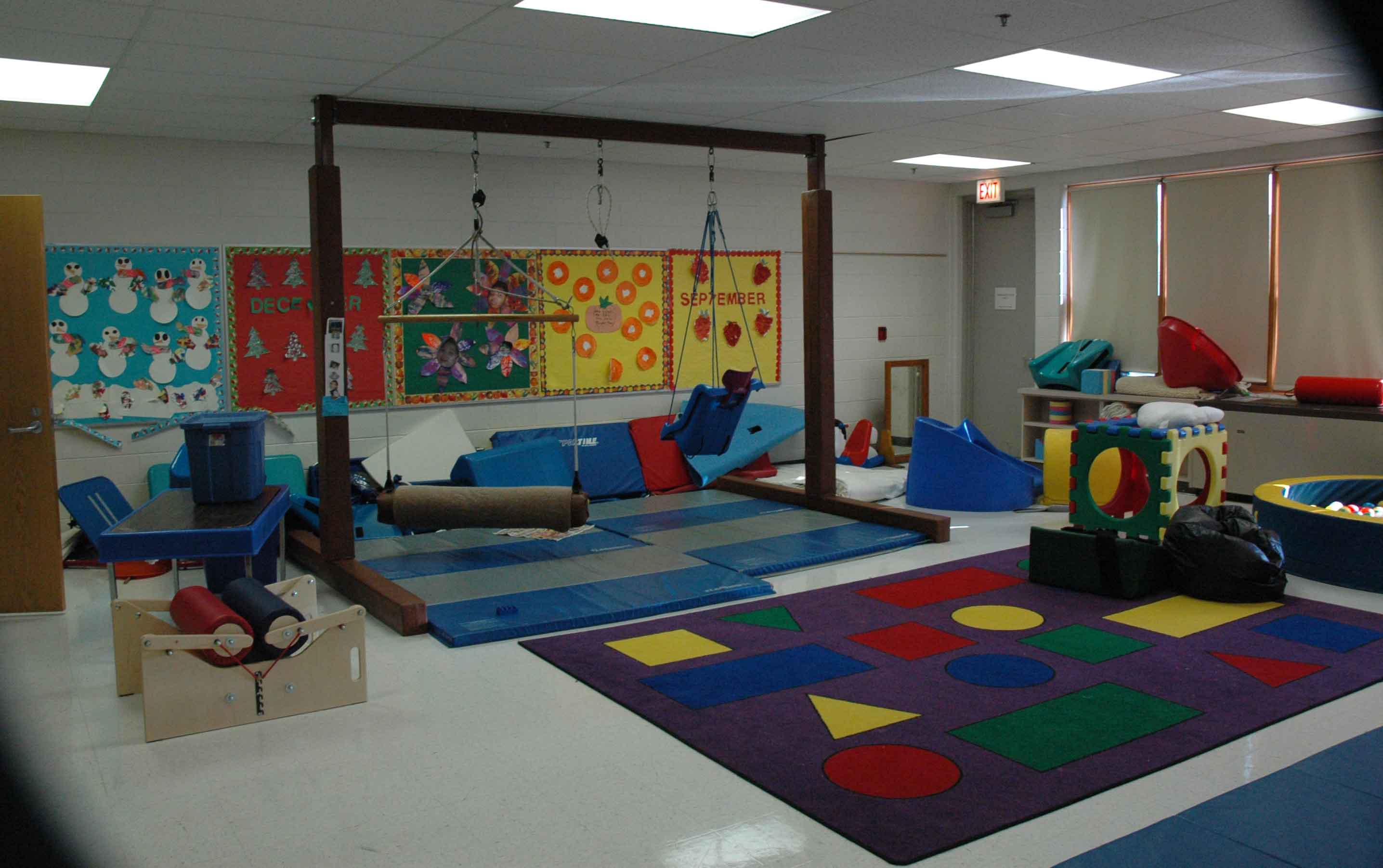 Children with severe disabilities play on specially designed gym equipment, such as those at the Blair Early Childhood school in Chicago. Substance photo by George N. Schmidt. The Chicago Board of Education has attempted to address recess in several ways: In the 2008 annual spring calendar memo, talking about the next year’s schedule, they encouraged schools to allow 8 – 10 minutes for recess. They also said that schools should have a recess provision written into the formal bell schedule which was submitted to the central office. 8-10 minutes of recess was part of the 2006 wellness policy, but most schools ignored it. Most involved, even at the central office don’t think ten minutes is enough. They say it’s a length of school day issue, but admit there are 50 minutes for non-instruction, 20 minutes of that is allowed for lunch. The other 30 minutes is used for reading stories. The older students have what is called a "sustained silent reading period" for 30 minutes. Teachers at my school are given the choice to use this period for recess. The trend in poor urban areas is to have high powered executives come in and read stories to children. The argument is that most poor children have limited vocabularies and literacy because they have never been read to. A popular argument in Chicago is that recess cannot be provided unless individual schools exercise their option to extend their school day. Teachers are allowed to opt out of their lunch hour. Individual schools are allowed to vote to shorten their school day without a pay difference, and push their 45 minute lunch period to the end of the day, at 2:45. Very few schools still operate on the longer schedule. This was a time when students walked home for lunch, back in the 70’s, and teachers had a duty-free period. But even when the schools had the longer day, students had a morning and afternoon recess, 15 minutes each.
Children with severe disabilities play on specially designed gym equipment, such as those at the Blair Early Childhood school in Chicago. Substance photo by George N. Schmidt. The Chicago Board of Education has attempted to address recess in several ways: In the 2008 annual spring calendar memo, talking about the next year’s schedule, they encouraged schools to allow 8 – 10 minutes for recess. They also said that schools should have a recess provision written into the formal bell schedule which was submitted to the central office. 8-10 minutes of recess was part of the 2006 wellness policy, but most schools ignored it. Most involved, even at the central office don’t think ten minutes is enough. They say it’s a length of school day issue, but admit there are 50 minutes for non-instruction, 20 minutes of that is allowed for lunch. The other 30 minutes is used for reading stories. The older students have what is called a "sustained silent reading period" for 30 minutes. Teachers at my school are given the choice to use this period for recess. The trend in poor urban areas is to have high powered executives come in and read stories to children. The argument is that most poor children have limited vocabularies and literacy because they have never been read to. A popular argument in Chicago is that recess cannot be provided unless individual schools exercise their option to extend their school day. Teachers are allowed to opt out of their lunch hour. Individual schools are allowed to vote to shorten their school day without a pay difference, and push their 45 minute lunch period to the end of the day, at 2:45. Very few schools still operate on the longer schedule. This was a time when students walked home for lunch, back in the 70’s, and teachers had a duty-free period. But even when the schools had the longer day, students had a morning and afternoon recess, 15 minutes each.
Last spring, Arne Duncan tried to get area instructional offices to identify schools which were in high crime areas that had students with limited opportunities for play, and petitioned them to adopt the extra 45 minutes into their school day in order to have recess. He hoped to find 30 schools, 23 were asked, and only three actually did it.
Various reasons were given, the school was already going through a major turnaround effort effecting the schedule, teachers didn’t want the longer school day, or the school just didn’t want to deal with recess.
Asking for change from a huge bureaucracy requires patience. For my adult recess, I race sailboats. Chicago’s most famous regatta is the race to Mackinac Island....
My first Mac race, was in 2004, the year I started fighting for recess; 2004 was the slowest Chicago-Mac race in history. The wind died. We were dead in the water, with the same lighthouse in view for two full days. But we did not give up. Eventually we made it to the island. I find this issue, bringing back recess, similar to the problem to being in a boat, sails up, with no wind. The only variable that I can hope to change is the wind. I pushed for recess for three years with no wind. The boat just sat there, sails dead. Slowly the wind started blowing. Not enough to get the boat going, but enough to turn the boat in the right direction. Sailing in the right direction is a good start. At first I think recess advocates get angry and look for legislation to solve all of their problems. Baby steps in the right direction are much better than creating laws which we have no prayer of defending against the huge law departments most city school districts have available. And even though we may be successful in getting recess back for students, ten years from now, there could be a different mayor which does not believe in it, a school board management that decides it is not necessary. Then play activists will have to start over. And even when school management and state legislatures commit to recess, schools still get away with not providing it. Getting recess rights for our children has to be a concentrated effort with support from all levels of the system.
The vast majority of suburban districts have guaranteed multiple daily recesses, and city district schools do not.
Why is this? Many school leadership officials make the open statement, “Recess isn’t all that important, my children do fine without it”.
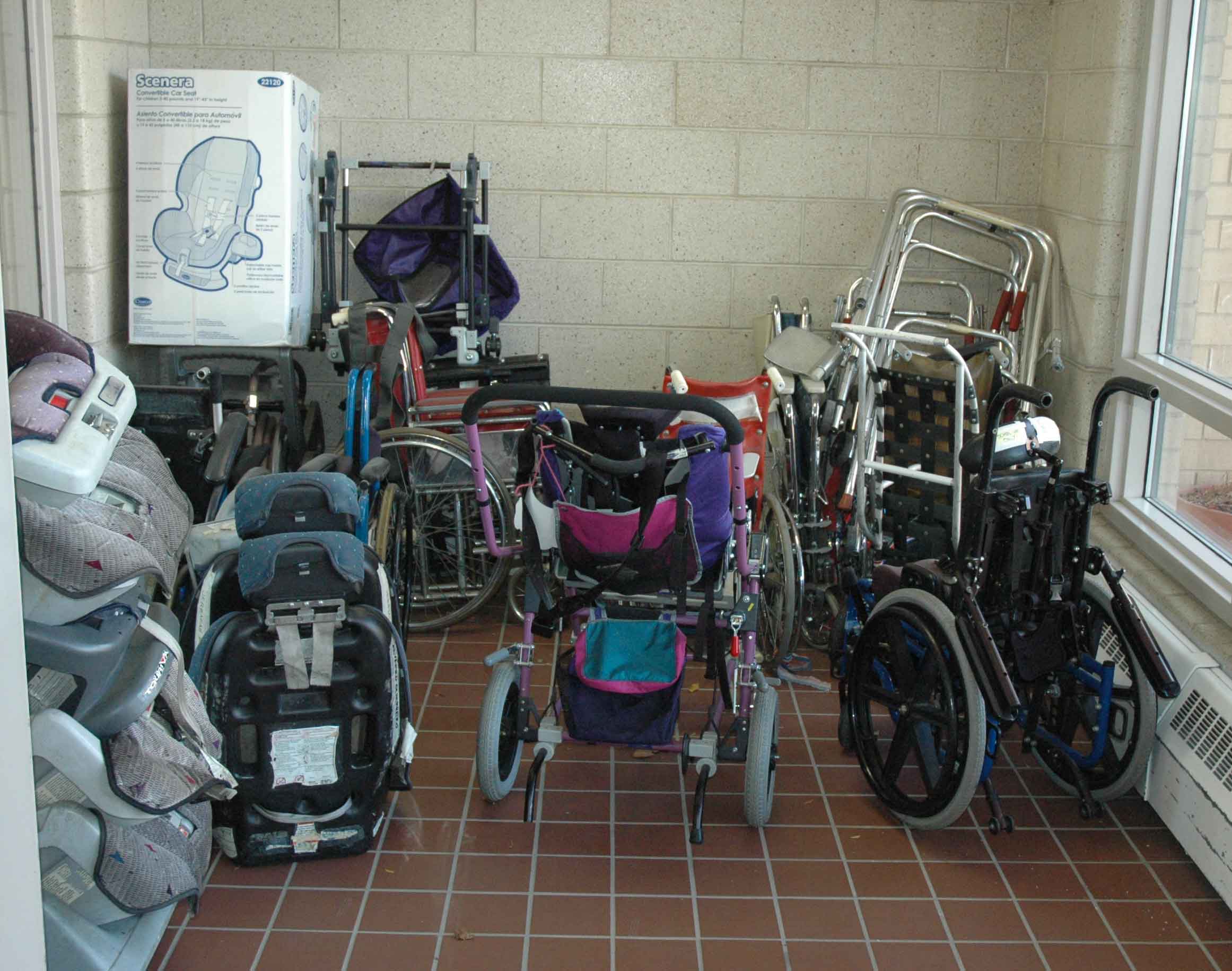 Children at Blair often need special apparatus to move around. They still benefit greatly from both recess and regular physical education. Substance photo by George N. Schmidt. I have a few smart geeky friends, who tell me, “I hated recess as a kid. I was always alone.”
Children at Blair often need special apparatus to move around. They still benefit greatly from both recess and regular physical education. Substance photo by George N. Schmidt. I have a few smart geeky friends, who tell me, “I hated recess as a kid. I was always alone.”
These inclinations are poison to the efforts of those of us who feel it is a necessity. What any school wants to do is raise its average test scores. To do that you have to look at those children who are scoring in the lowest range, figure out why they are just not motivated to come to school, assess why they can’t seem to function competitively.
It’s very tough to expect change from many urban education leaders, because they do not want their children to be exposed to lower class slang language. At one point, most city neighborhoods were white. When they started going black, the schools were a place of culture wars. When children played on the playground together, the majority group wins. I myself was concerned about this issue. Many of my neighbors sent their children to mostly white Catholic schools, instead of the public school. When discussing school choices, before I enrolled my kids, parents would say, “Yes, my kids were at the public school until 4th grade, when they started coming home with an accent.”
I realized that many of the phrases I used around the house were less than perfect, and many of the children I met in the neighborhood that didn't look like my children had so many other great qualities to offer, created a real richness in their personal and play life.
Language is a major reason recess was dismissed among city schools in the last 30 years. This isn’t just white people not wanting their children around Johnny No No who talks dirty and has a heavy accent. It’s upwardly mobile black families that are trying to get their children away from it. When you see that Chicago’s schools only allow enough time to eat lunch, don’t even allow the students a 15 minute social break, you have to wonder if this isn’t a reason for the design. Most city neighborhoods are not homogeneous like suburban neighborhoods. Usually, the higher social classes are the minority, and this group is also likely to have control of the school board and school policy making process.
One of the reasons urban black language is so heavy and portrays a downward, depressing vibe, is that they have not had much of a chance to develop their linguistic muscles. They are rarely in situations where they get to practice language with people who do not speak like them. For those who go to school with teachers who speak with a more typical middle American accent, who have friends of different backgrounds, they end up talking in two languages. One is so heavy, I can’t understand half of what they are saying. The more they get a chance to practice talking with each other, they grow out of what they learn in their home environment, and create their own language. Any of us, if we don’t use our vocabulary, for some reason go several days with limited opportunities to talk, will slur and stumble.
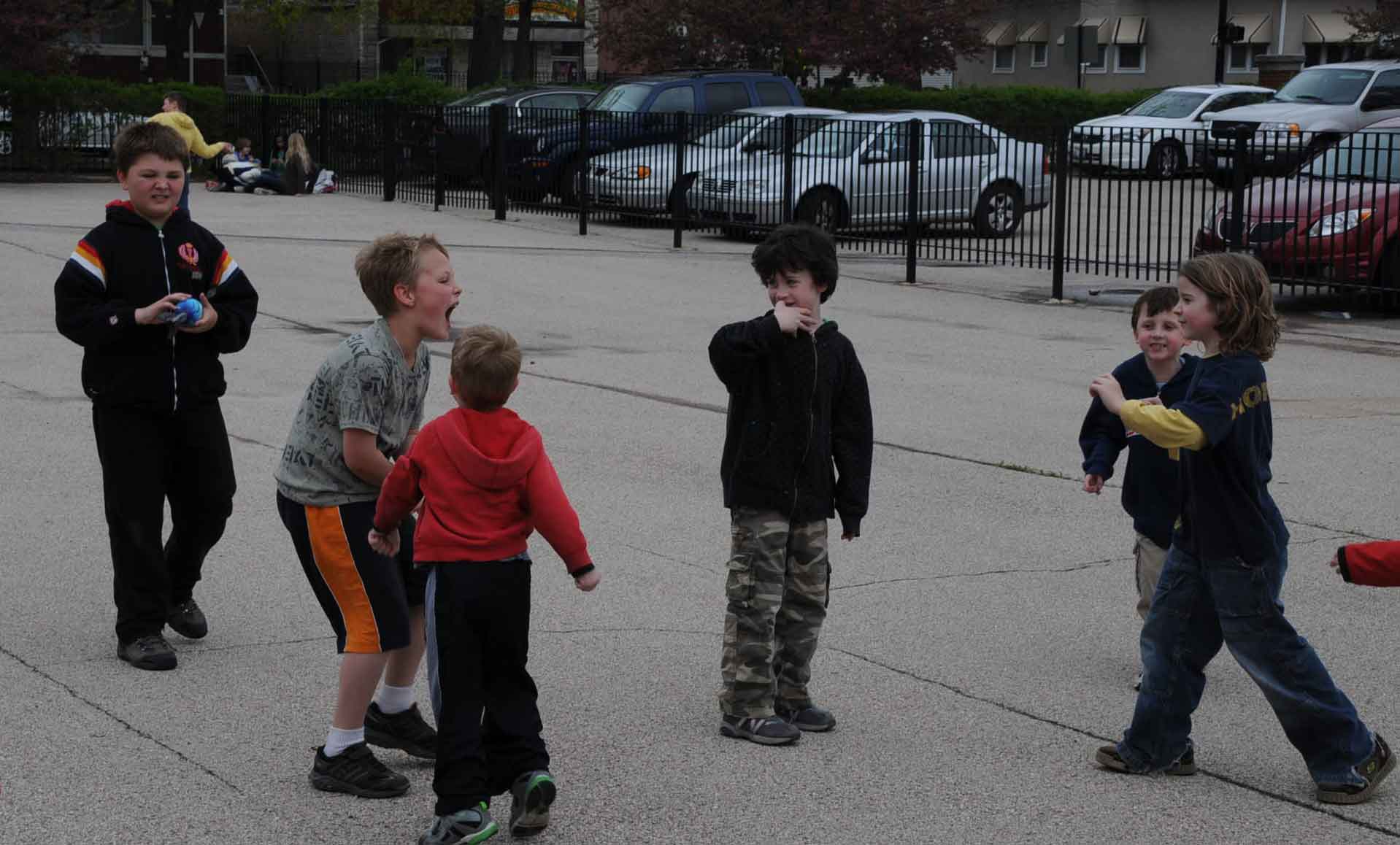 Thorp boys enjoy "rough and tumble" play. Substance photo by George N. Schmidt.The reality in many classrooms today, is that children are being expected to sit with one another for 6-7 hours at a time without conversing. Any talk is considered bad behavior. Our district has a 20-minute lunch. The children are not allowed to talk for the first ten minutes, to ensure they eat. Ten minutes to talk, finish lunch and clear their garbage?
Thorp boys enjoy "rough and tumble" play. Substance photo by George N. Schmidt.The reality in many classrooms today, is that children are being expected to sit with one another for 6-7 hours at a time without conversing. Any talk is considered bad behavior. Our district has a 20-minute lunch. The children are not allowed to talk for the first ten minutes, to ensure they eat. Ten minutes to talk, finish lunch and clear their garbage?
I think that if we get enough concerned citizens to help get children outdoors for recess in unsafe neighborhoods, you will find these same groups of adults and children will end up at the school playground or park, after school, to continue their play. The risk of violence is perceived to be an all day threat, but it usually occurs after sundown on busy street corners. Play lots, with enough adult presence, are most likely going to be OK during daylight hours. Another thing that is found, is that youth who do not get adequate physical activity before evening, become more active as the sun goes down. This is an issue with sleep disorders, as well as for youth who have violent tendencies, who feel listless as the night begins.
Smoking cigarettes as a child is the gateway drug to a lifetime of addiction. Regular play as a child is the gateway activity to a lifetime of healthy mental balance. Unfortunately, colleges are seeing a generation of students who have an increased rate of depression, anxiety, perfectionism and stress. What do young adults who haven’t discovered creative solutions to stress turn to? Alcohol and drugs.
One of the predominant arguments against pro-recess research is that play deprived children receive so much developmental retardation before they make it to school that there is no amount of school recess that will heal the damage.
Researchers have worked with orphans who are sensory deprived. The simple rocking motion of being held and play swinging a baby up and down, as well as the cooing parents give their children has an effect on later emotional development. These researchers would have us believe that poor parents provide nothing to their children, that these children are a hopeless cause. This is a pretty tough argument to make. The human spirit has a huge capacity to heal, no matter how severe the sensory deprivation, or how long it occurred.
There is an anti-gravity component in all early play, leaping upward, everyone leaps with joy. As children get older, there are chasing games, taking turns who chases who, lion cubs do it, dogs do it. It’s a sharing of the new phenomenon of power. Play refreshes and energizes, allows burdens to feel lighter, and opens us to new possibilities. It is a central element to life, like nutrition and sleep.
For more great information on play, visit Touch the Future, at www.ttfuture.org, and the National Institute for Play, at www.nif play.org.


By: Sid Skippy Marcus
the lack of recess and exercise for schol children
Please contact Amy Lux for me and have her e-mail me ASAP. I am presently involved with CPS and would like to discuss some important issues with her. Thanks Sid Skippy Marcus